Steamed fish with soy sauce and ginger is the perfect family-style fish dish. It’s easy to prepare, healthy, and packed with delicious aromatics. This impressive and flavorful meal is sure to wow your friends and family!
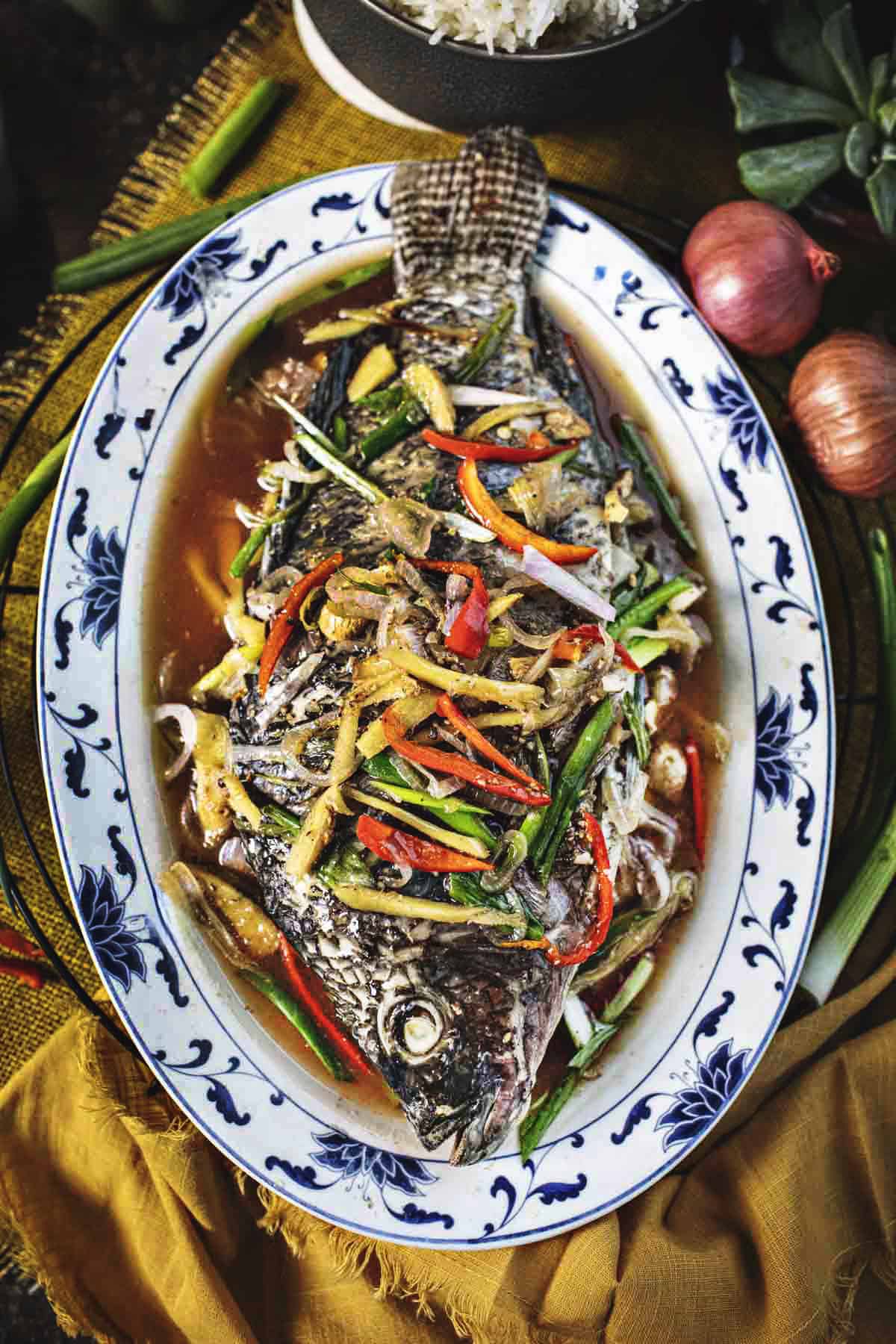
In Thailand, Chinese cuisine has dramatically influenced our food culture through generations of Chinese immigrants. From stir-fries to soups and appetizers, steamed fish is one of the favorite recipes enjoyed across all regions. In bustling areas like Chinatown in Bangkok, steamed whole fish with ginger and soy sauce is a popular menu item in many restaurants.
For more delicious fish recipes, check out my Pla Pao-salted whole fish, Jungle curry with fish, cod in red curry, and Thai catfish stir-fry with red curry paste. These dishes are sure to add variety and excitement to your meal plans!
Jump to:
- What Is Steamed Fish with Soy Sauce?
- Why You’ll Love This Steamed Fish Recipe
- Ingredients for Steamed Fish with Soy Sauce
- How to Steam Whole Fish
- How to Serve Whole Fish
- Whole Fish vs. Fish Fillets
- Tips for the Best Chinese Steamed Whole Fish
- Helpful Kitchen Tools
- Storing Leftover Whole Fish
- More Thai Recipes You'll Love
- Frequently Asked Questions
- Steamed Fish with Soy Sauce
- More Fish Recipes
What Is Steamed Fish with Soy Sauce?
Steamed fish with soy sauce is a classic Chinese-style dish, often called Cantonese steamed fish. This traditional recipe highlights the natural sweetness of fresh fish, enhanced by a fragrant soy sauce mixture, fresh ginger, and garlic. Whether you use a whole fish or fish fillets, steaming preserves moisture, resulting in tender, flaky flesh. It’s a beloved Chinese fish dish enjoyed by many Thais, perfect for celebrations like Chinese New Year or as a simple, delicious meal year-round.
Why You’ll Love This Steamed Fish Recipe
- Simple and Fresh Ingredients: For this Chinese steamed fish, you only need fresh fish, aromatics, soy sauce, and a little oyster sauce to create a restaurant-quality meal.
- Fast and Easy Dish: With minimal prep and a quick steaming time, this steamed fish recipe comes together faster than you’d think.
- Perfect Main Dish: This simple dish is excellent as a centerpiece for your family-style meal. Your steamed whole fish is sure to be a conversation starter!
- Healthy & Delicious: Steaming locks in nutrients, making this a light yet flavorful option that pairs perfectly with white rice or noodles.
Ingredients for Steamed Fish with Soy Sauce
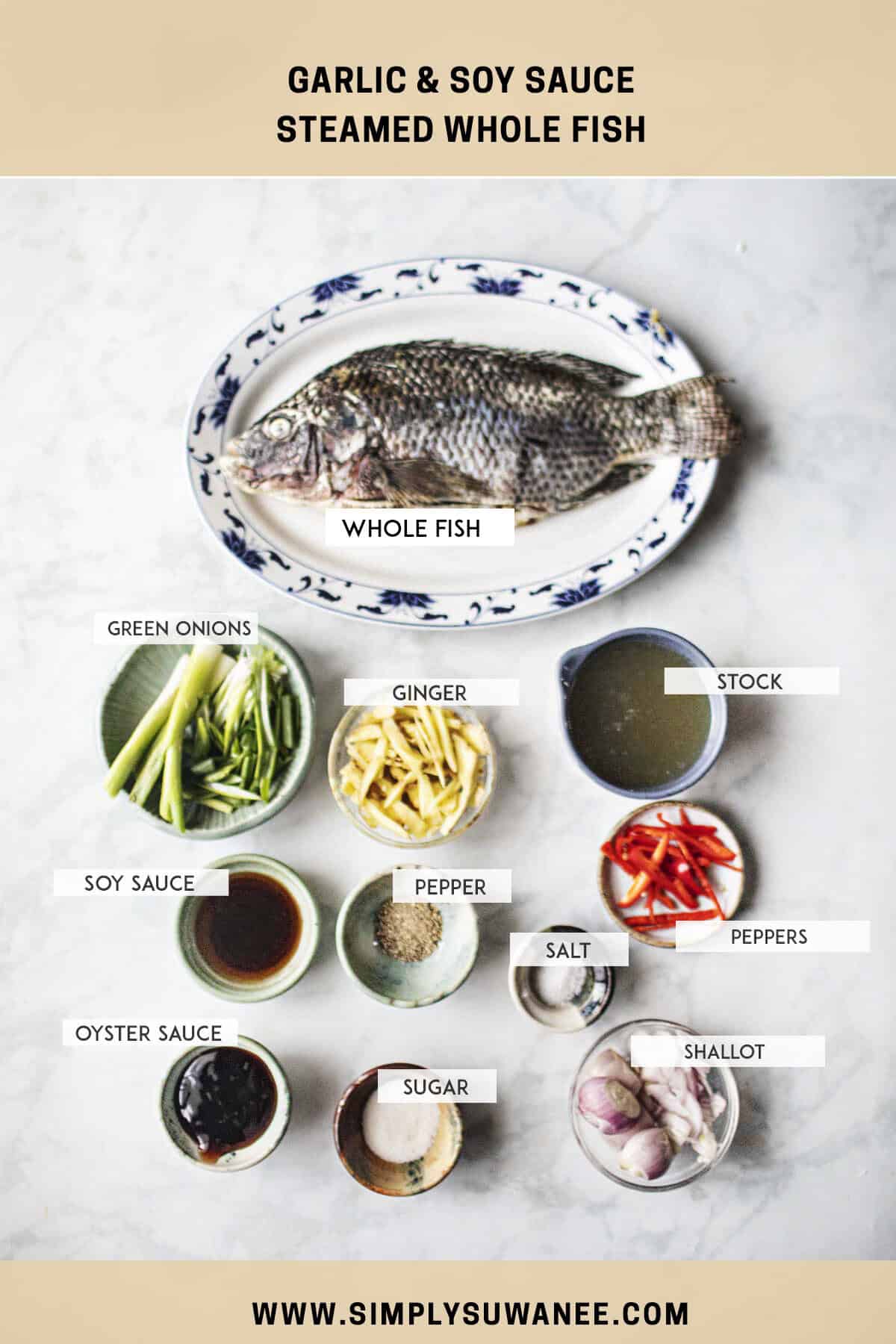
- Whole Fish (Tilapia, Red Snapper, Sea Bass, Sea Bream, or White Fish): Choose plump fish with clear eyes and no fishy smell. These types of fish stay tender and flavorful during steaming.
- Ginger: Adds zesty, aromatic depth, infusing the fish with warm, spicy notes.
- Shallot: For added flavors and aroma.
- Green Onion: Provides a fresh, mild onion flavor and a pop of color.
- Red Peppers (Hot or Sweet): Adds vibrant color and can provide a spicy kick or sweet crunch.
- Soy Sauce: Delivers a salty umami flavor that deeply penetrates the fish.
- Oyster Sauce: Adds velvety, rich flavor and complexity, giving the sauce a glossy finish.
- Salt: Enhances the fish's natural flavors and balances the seasoning.
- Sugar: Balances the savory soy and oyster sauces with umami flavors.
- Ground Pepper: Adds mild heat and subtle pungency. Use black or white pepper.
- Stock (Chicken or Vegetable): Creates a flavorful broth that keeps the fish moist and enriches the sauce. Dried shiitake mushroom stock adds extra umami.
- Oil. Use vegetable, canola, and avocado or high-heat cooking oil.
- Optional ingredients: For extra flavor, add 1–2 teaspoons of Chinese Shaoxing wine and toasted sesame oil to your soy sauce mixture.
How to Steam Whole Fish
1. Clean and Prep: Descale, remove innards, and rinse well. Pat dry with paper towels. Make two or three slits along the top of the fish to help flavors penetrate. Rub salt all over the fish, including the interior part in the belly area.
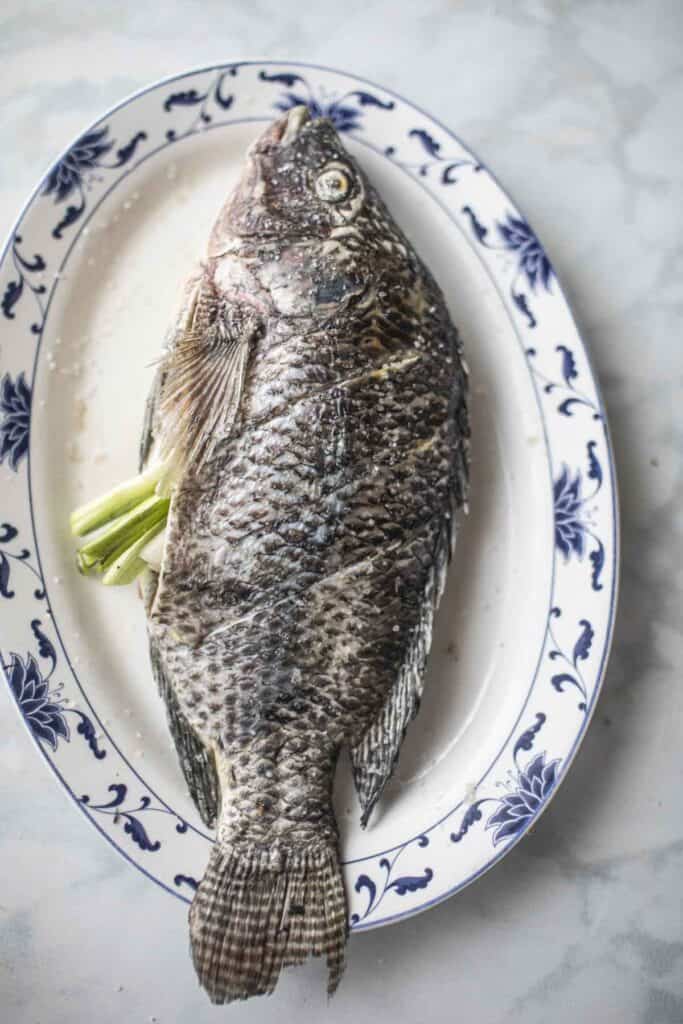
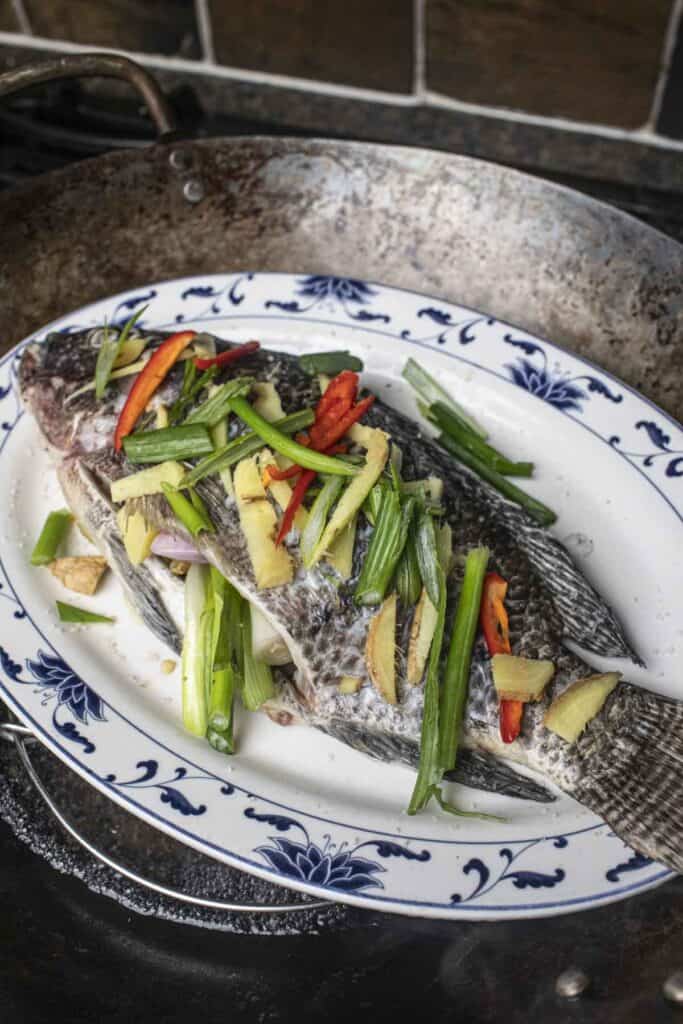
2. Stuff with Aromatics: Divide the aromatics in half. Use one portion for steaming and the other for the soy sauce seasoning. Gently crush the ginger, garlic, and green onion to release their flavors. Stuff them inside the fish’s belly and tuck some into the slits on the sides. Place a few aromatics on top and reserve red pepper slices and green onion tops for garnish.
3. Set Up Your Steamer: Fill a large wok or big steamer basket with a few inches of water. Put a steamer rack inside, then place the fish on a heatproof platter. Bring it to a simmer. If your lid doesn’t fit over the entire fish, you can wrap foil around the fish or trim the tail as needed. See the image below.
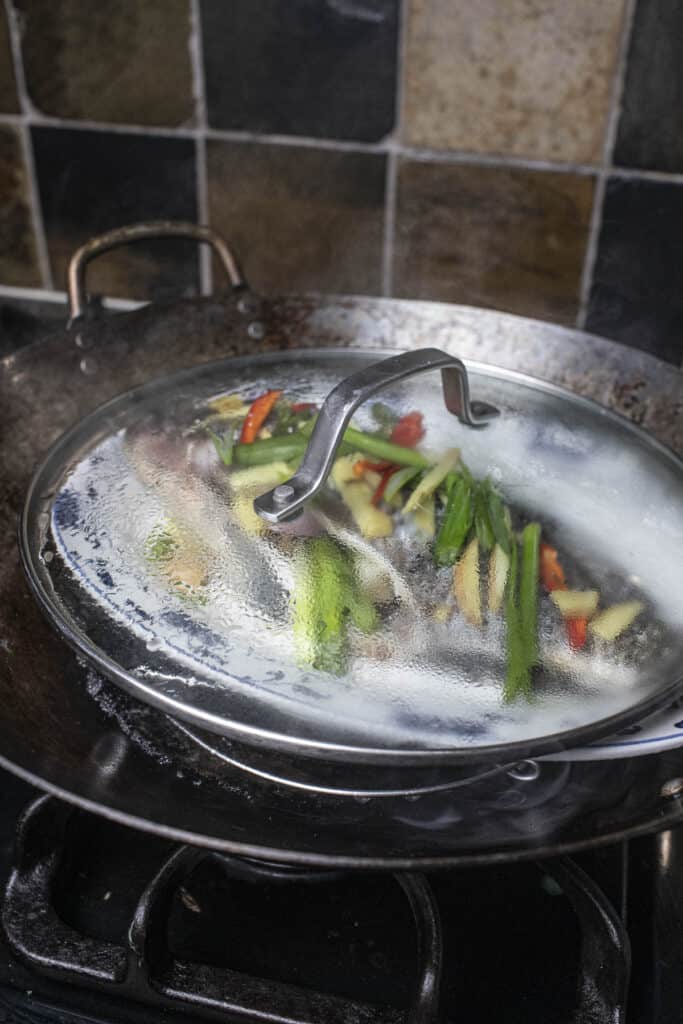
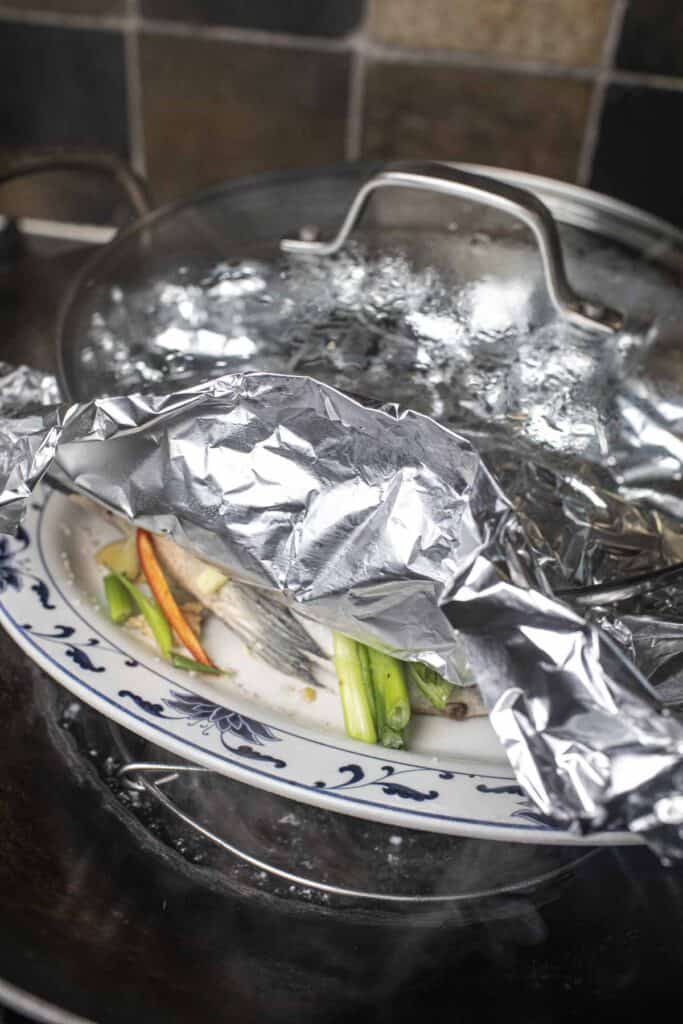
4. Steam the Fish: Carefully lower the platter onto the steamer rack. Steam fish for 10–15 minutes, depending on the fish’s thickness. Check for doneness at the thickest part of the fish—it should flake easily at around 135°F internal temperature.
5. Prepare the Soy Sauce Mixture: While the fish steams, in a small saucepan, sauté your remaining aromatics in vegetable oil or sesame oil until fragrant. Add soy sauce, oyster sauce, sugar and pepper. Adjust the seasoning to taste. Saute until salt and sugar melt, then set aside.
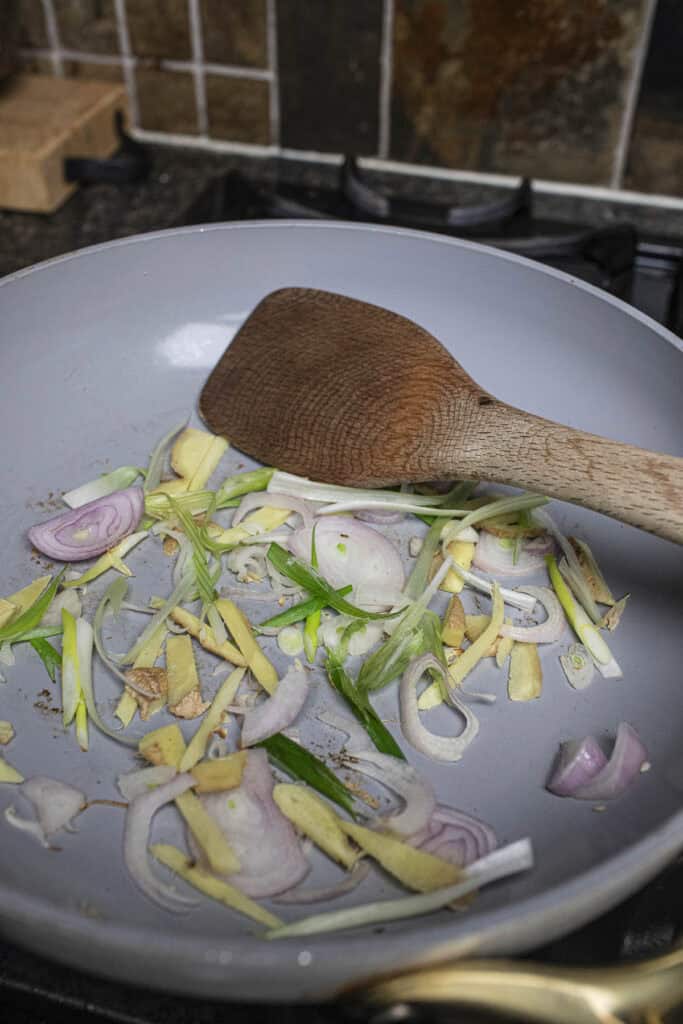
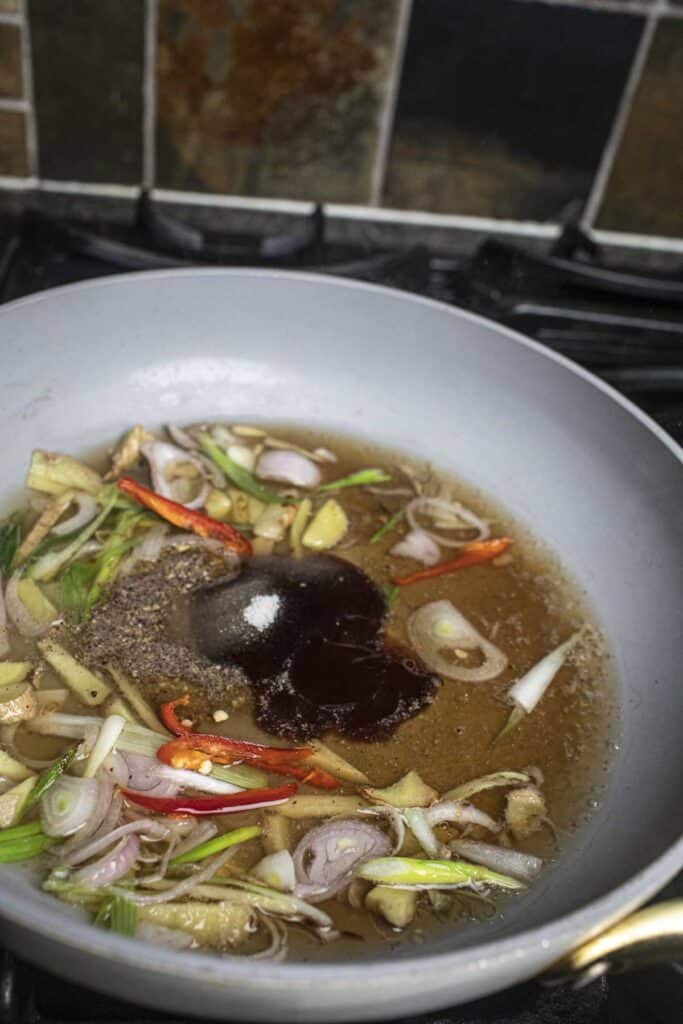
6. Finish and Serve: Once the fish is done, pour the hot soy sauce mixture over it. Top with extra ginger, spring onions, or fresh red peppers. Serve immediately.
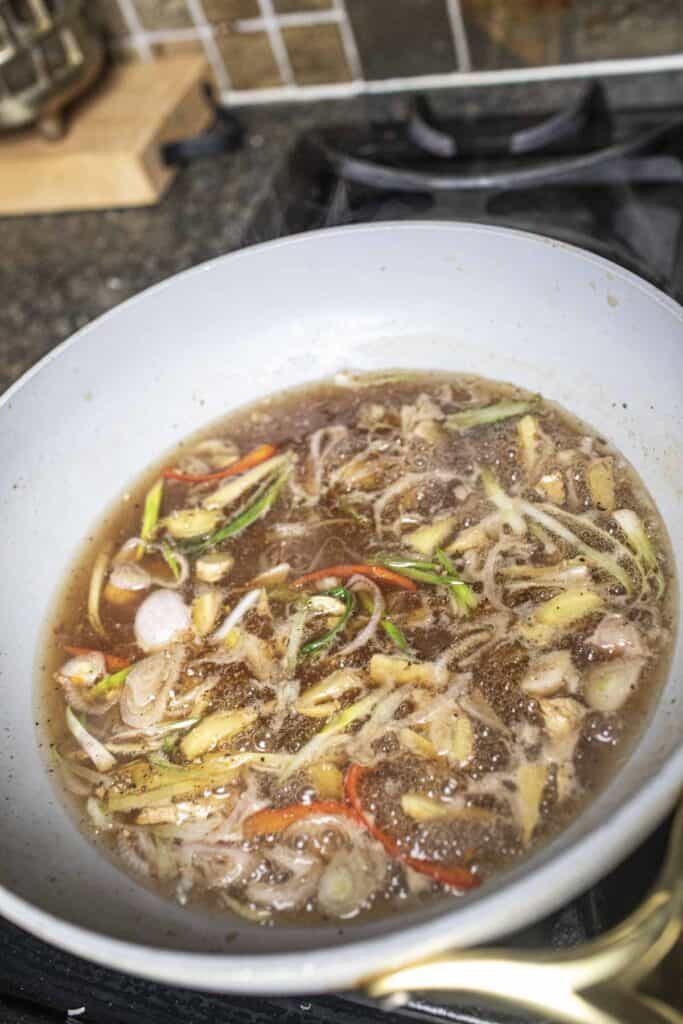
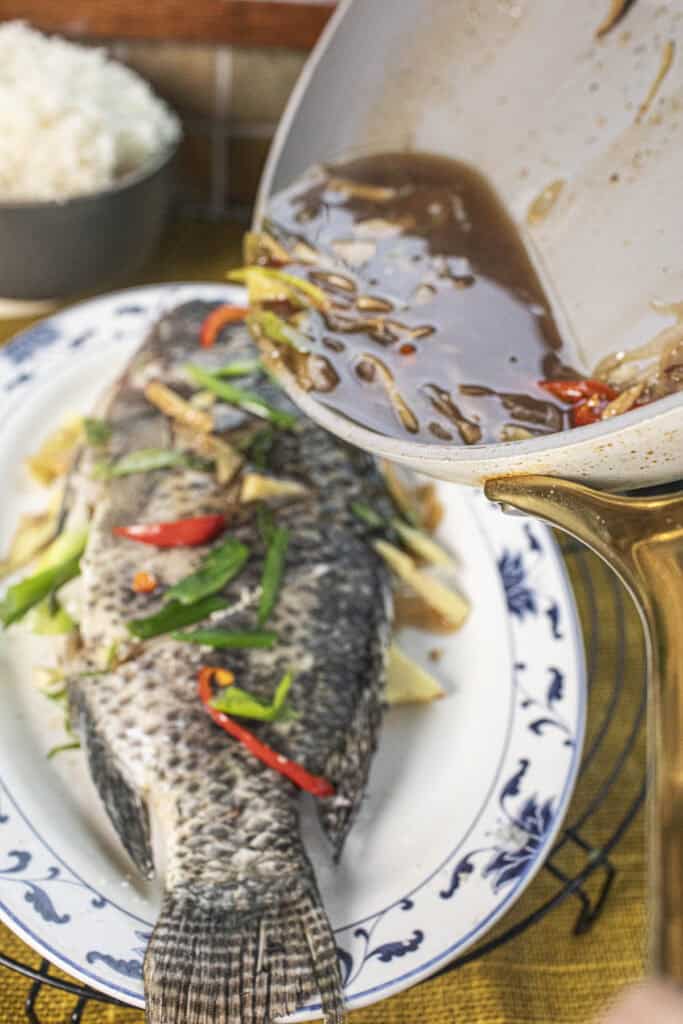
How to Serve Whole Fish
Serving steamed whole fish is a highlight in many Thai and Chinese fish dishes—especially around special occasions like Chinese New Year, symbolizing good luck and prosperity.
Place the fish in the middle of the table for a family-style meal. Everyone can pick their favorite parts, being mindful of bones. Pair with sides like stir-fried veggies, noodles, or soup to round out the feast.
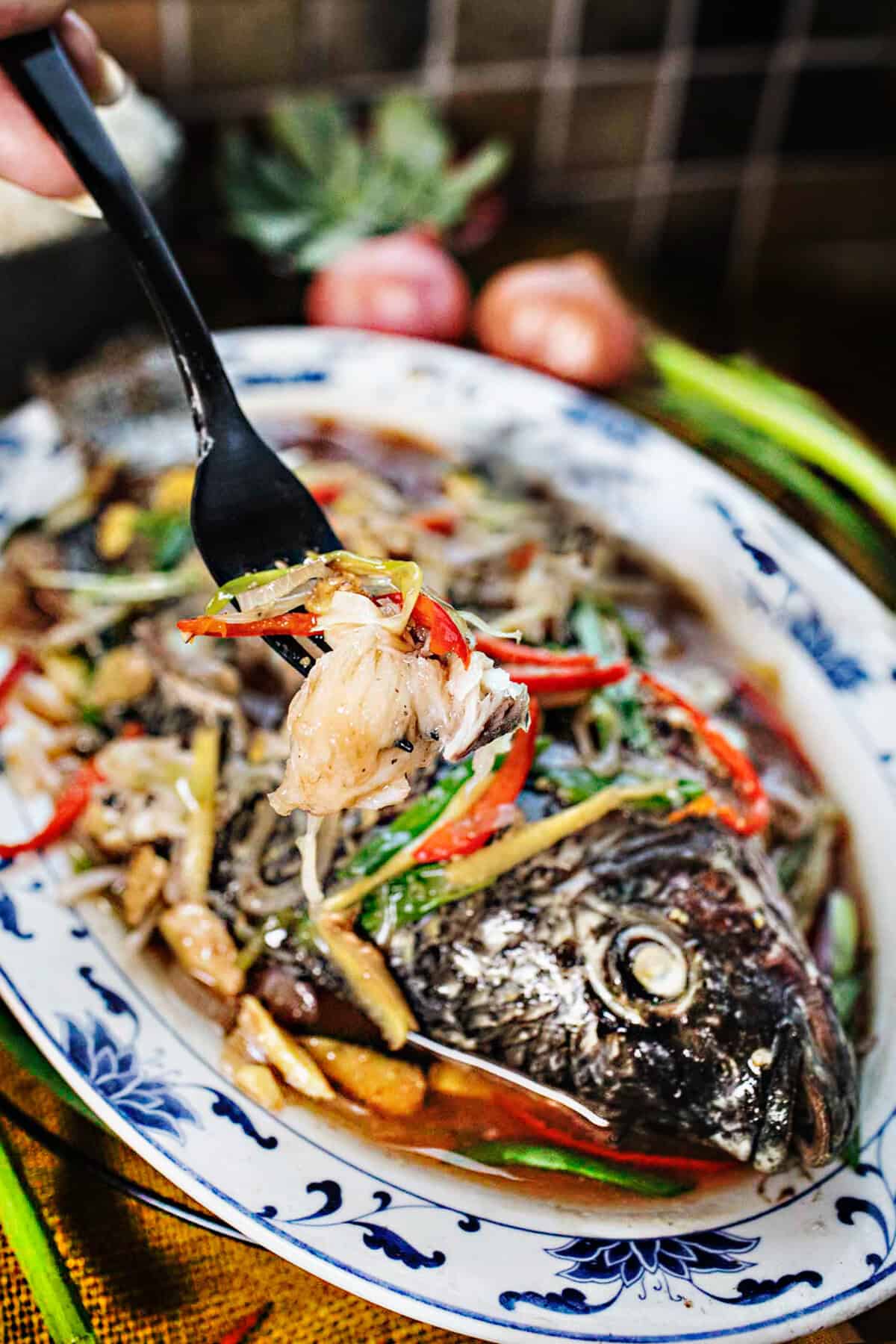
Whole Fish vs. Fish Fillets
- Steamed Whole Fish: Delivers a rich, natural sweetness since bones and skin add extra flavor. It’s also a traditional choice for Thai or Cantonese steamed fish and more festive for large gatherings.
- Steamed Fish Fillets: More convenient if you want fewer bones and quicker cooking. Steamed fish fillet versions are perfect when you have limited time or guests who prefer boneless options. Either way, steaming fish fillets or whole fish in soy sauce is a delicious way to keep the meat moist and tender.
Tips for the Best Chinese Steamed Whole Fish
- Choose plump fish like tilapia, red snapper, sea bass, or sea bream. These types of fish have thick, meaty sections below the dorsal fins that stay tender and flavorful during steaming.
- Always look for the freshest fish possible. Fresh fish should have clear eyes and shiny, firm skin. Avoid any with a strong fishy smell, as this indicates the fish may not be fresh.
- Head to your local fishmonger to select your whole fish. A knowledgeable fish monger can help you pick the best whole fish and make sure it’s fresh.
- Save the fish carcass, especially the fish head, to make a flavorful broth. The rich flavors from the fish head create an excellent vegetarian broth that you can use in your future recipes.
- If you’re using frozen fish, make sure to let it thaw completely in the refrigerator before steaming for the best tender and flakey steamed fish.
Helpful Kitchen Tools
Storing Leftover Whole Fish
If you have leftover steamed fish, store the whole fish, with bones in, in an airtight container in the fridge for up to 2 days. To reheat, gently steam it again or use the microwave, keeping in mind that reheating might slightly change the texture. If the fish feels a bit dry, drizzle some soy sauce and a splash of water over it before reheating to keep it moist and flavorful.
More Thai Recipes You'll Love
Frequently Asked Questions
Use fish carcasses to make a rich and flavorful fish stock. Simmer the bones with aromatics like onions, garlic, ginger, and herbs for about an hour. Strain the liquid, and you’ll have a homemade stock perfect for soups, stews, and sauces.
Yes, you can! Simply choose your favorite white fish fillets and steam them just like a whole fish. Fillets cook faster and are easier to handle, making them a convenient option for this steamed fish with ginger and soy sauce recipe.
Use a large pot or wok with a steaming rack. Add a few inches of water, place the fish on a heatproof platter, and steam over high heat until it’s fully cooked.
Steaming fish is a staple in Asian cuisine, but Western chefs have traditionally preferred roasting or deep frying. Recently, however, many are embracing Asian steamed fish for its healthy, clean flavor.
They’re different experiences. Steamed fish retains natural moisture and sweetness, while fried fish is crispier. Both can be delicious in their own way.
**Love a recipe you've tried? Please leave a 5-star rating in the recipe card below and a review in the comments section further down the page. Or follow me on Facebook, Pinterest, or Instagram!**
Print
Steamed Fish with Soy Sauce
- Total Time: 30 minutes
- Yield: 4-5 servings
- Diet: Low Calorie
Description
Chinese-style Steamed fish with soy sauce and ginger is the perfect family-style fish dish. It’s easy to prepare, healthy, and packed with delicious aromatics. This impressive and flavorful meal is sure to wow your friends and family!
Ingredients
- Whole fish, around 2 pounds. Choose tilapia, red snapper, sea bass, sea bream, or white fish.
- 1 teaspoon salt, for rubbing on the fish before steaming
- 1 tablespoon oil. Vegetable, avocado, canola, or rice bran oil.
- ¼ cup ginger, thinly sliced into matchstick sizes
- ½ cup green onion, sliced long and thing about 2-inch pieces
- ⅓ cup shallot, sliced long and thin
- ⅓ cup red peppers. Choose hot peppers for heat or sweet bell peppers for no heat, sliced long and thin.
- 2 tablespoons soy sauce
- 1 ½ tablespoons oyster sauce
- 2 teaspoons sugar
- ½ teaspoon ground pepper. Add more as needed
- ½ cup stock (unsalted chicken or vegetable)
- optional ingredients: add 1-2 teaspoons Chinese Shaoxing wine or toasted sesame oil to your soy sauce mixture for extra flavor
Instructions
- Clean and Prep: Descale, remove innards, and rinse well. Pat dry with paper towels. Make two or three slits along the top of the fish to help flavors penetrate. Rub salt all over the fish, including the interior part in the belly area.
- Stuff with Aromatics: Divide the aromatics in half. Use one portion for steaming and the other for the soy sauce seasoning. Gently crush the ginger, garlic, and green onion to release their flavors. Stuff them inside the fish’s belly and tuck some into the slits on the sides. Place a few aromatics on top and reserve red pepper slices and green onion tops for garnish.
- Set Up Your Steamer: Fill a large wok or big steamer basket with a few inches of water. Put a steamer rack inside, then place the fish on a heatproof platter. Bring it to a simmer. If your lid doesn’t fit over the entire fish, you can wrap foil around the fish or trim the tail as needed. See the image below.
- Steam the Fish: Carefully lower the platter onto the steamer rack. Steam fish for 10–15 minutes, depending on the fish’s thickness. Check for doneness at the thickest part of the fish—it should flake easily at around 135°F internal temperature.
- Prepare the Soy Sauce Mixture: While the fish steams, sauté your remaining aromatics in vegetable oil or sesame oil in a small saucepan until fragrant. Add soy sauce, oyster sauce, sugar and pepper. Adjust the seasoning to taste. Saute until salt and sugar melt, then set aside.
- Finish and Serve: Once the fish is done, pour the hot soy sauce mixture over it. Top with extra ginger, spring onions, or fresh red peppers. Serve immediately.
Notes
- Choose plump fish like tilapia, red snapper, sea bass, or sea bream. These types of fish have thick, meaty sections below the dorsal fins that stay tender and flavorful during steaming.
- Always look for the freshest fish possible. Fresh fish should have clear eyes and shiny, firm skin. Avoid any with a strong fishy smell, as this indicates the fish may not be fresh.
- Head to your local fishmonger to select your whole fish. A knowledgeable fish monger can help you pick the best whole fish and make sure it’s fresh.
- Save the fish carcass, especially the fish head, to make a flavorful broth. The rich flavors from the fish head create an excellent vegetarian broth that you can use in your future recipes.
- If you’re using frozen fish, make sure to let it thaw completely in the refrigerator before steaming for the best tender and flakey steamed fish.
- Prep Time: 10
- Cook Time: 20
- Category: fish recipes
- Method: steaming
- Cuisine: chinese, thai, international
More Fish Recipes
Looking for other recipes like this? Try these fish recipes you'll love!

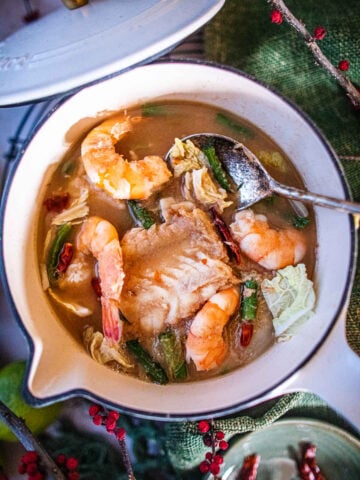



Leave a Reply